William Tranter was a British gunmaker of some repute, although generally not remembered today. He was apprenticed to a gunsmith in 1830, at the age of 14, and by 1839 had left and opened his own shop. He quickly became a well known and well respected member of the London gun trade, and his first really significant work was the production of thousands of Adams revolvers under license.
Around 1853 Tranter began designing, patenting, and producing his own firearms, primarily revolvers (he was eventually in active production of more than 20 different models) but also rifles, including Sniders on contract for the British Army. He was a founding member of BSA (Birmingham Small Arms), played a role in development of the Mk.I Enfield service revolver, and much more.
I learned this with a bit of quick research – I really don’t know much at all about the man or his gun designs. However, I had a reader named Kevin send me a bunch of photos of a Tranter revolver he has inherited, a six-shot model in a rather awe-inspiring .577 caliber:
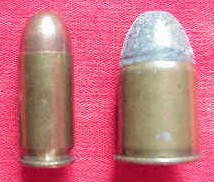
Right: .577 Tranter
From what I can tell, at least three different firms had licenses to build these ludicrously huge revolvers – Webley, Braendelin, and Tipping & Lawden, in addition to Tranter himself. Does anyone know enough about them to provide any additional information on where this one might have been made, or its value? There was a book written in 2007 on Tranter weapons (Tranter Cartridge Firearms), but it is out of print now and I don’t have access to a copy. I think the upturned point on the top of the grip points to this one being made by Webley, but I can’t confirm that. Any input from folks with knowledge on the subject would be much appreciated – thanks!

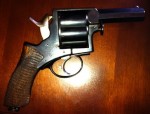
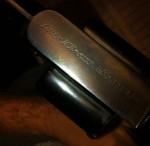
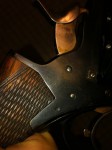
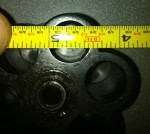
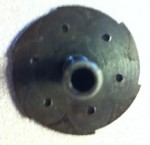



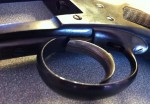
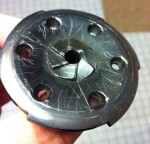
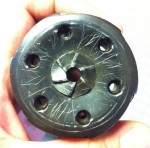






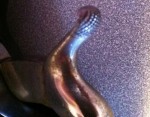

http://i1244.photobucket.com/albums/gg578/snidervolley/IMG_1259_zps6c10c622.jpg
http://s1244.photobucket.com/user/snidervolley/media/IMG_1259_zps6c10c622.jpg.html
my tranter
http://i1244.photobucket.com/albums/gg578/snidervolley/gggg329.jpg
http://i1244.photobucket.com/albums/gg578/snidervolley/thumper084.jpg
buisness end
Post about it at the Brtish Gun Pub at Gunboards.com. Several members there own them and some of the guys who “wrote the book” on British handguns hang out and post there. Tranters are not Forgotten Weapons there. Great old guns.
For information on Tranter go to http://www.oldguns.co.uk/william_tranter.html
Gwyn
Again http://www.oldguns.co.uk/william_tranter.html
Gwyn
a little over 14 mm! What is the recoil like? That is one scary business end Kymm.
I would hate to get shot by one of these… Anyone want to find performance figures? I assume that if the muzzle velocity isn’t high enough, a tree would be good protection from the projectile. But don’t use foliage to hide from any projectile weapon with more kinetic energy than arrows shot from long bows or cross bows.
450 grains @ 725fps = 525 ft-lbs. (Weight and velocity given in W.C. Dowell’s “The Webley Story”.)
From what I read a .577 revolver is a rare beast indeed. The owner might want to ask at the British Military Handguns forum here: http://britishmilitariaforums.yuku.com/forums/5/British-Military-Handguns#.Up9tDsRdWSq
If I recall correctly, Gary James has done 2 or 3 articles on the Tranter and other .577 revolvers in Guns and Ammo over the last decade. All part of the “Man Stopper” or “Howda Gun” class. I would LOVE to fire one of these….
While I’d have to go through 30-odd years of Shotgun News for a precise figure, a few Tranters were available in the late 70’s/early 80’s from either Hunters Lodge or Sarco for around $200. This was about the same time a bunch of Webley’s in .455 and -cheap- S&W 1917s glutted the market (Thanks PM Thatcher!). Very little ammo made it to this side of the ditch, however.
For .577 ammo, try a cut down 28 guage shot gun case for size.
Per Seyfried’s G&A article, he used .577 Nitro cases cut down to .800″ long.
Looking at the Photo Ian has posted, that appears to be a heeled bullet (like a .22 long rifle) the bullet is the same diameter or larger than the outside of the brass case, and a smaller diameter shank (heel) of the bullet fits into the case
(With upper-class British accent) “…But, being this is a .577 Tranter, the biggest God Damn revolver in the British Empire, and would make a rather large mess of things if I shoot you, you’ve got to ask yourself a question: Do I feel lucky. Well, do you, you rebel scum?”
Major Harold ‘Dirty Harry’ Callahan, 5th Cavalry, to native rebel.
Sorry, had to be the first.
I seem to remember something about some .600″ calibre British revolvers…
along with the 4 barrel double action pistols which, in the days of black powder were reckoned to be more reliable as an officer’s sidearm in battle than a revolver.
Fine if you have a team of Sherpas to carry the bloody thing and its ammunition for you ;^)
Here it is, Kieth. The big thumping Gilon: http://castboolits.gunloads.com/showthread.php?7146-American-Pioneer-Powder/page2
Man, both that and the Tranter are things of beauty. Wish someone today made a big, fat, slow round 🙁
“4 barrel double action pistols”
You’re probably thinking of Lancaster pistols
http://guns.wikia.com/wiki/Lancaster_Pistol
Note that action used in Lancaster pistols (revolving striker) was later used in COP .357 Derringer.
Tranter’s revolvers are absolutely beautifully made. In terms of features such as double action, and in terms of fit and finish, they were way ahead of the contemprary American competition, although it must be said that, before WWi and for several years after, Britain was the far bigger economy, with wealthier buyers, It would be a bit like comparing the quality of say Taurus, to say a Colt Python today.
A Friend’s father had a large (?the largest?) private collection of Tranters.
Unfortunately a couple could chamber currently available cases and were confiscated by the cops in the late 90s, and were likely destroyed.
Following his dad’s death, my friend held the collection for a few years but, in the end, had to send it to auction, in order for the other heirs to receive their share of the estate. I was out of Britain for those years and never got to have a close look at the guns before they were dispersed.
The commission to auction the collection, is claimed to have established the auction firm’s reputation!
http://www.antiquestradegazette.com/news/2005/may/13/pistol-gets-firm-off-to-a-record-start/
The .577 revolvers were made from the late 1860s (yes percussion ignition) until 1890. They were contemporary to the 15mm pinfire revolvers. Neither the .577 1 inch and the 15mm pinfire were as powerful as the double barrel “Howda” pistols of the day. Unlike the US which learned the value of a revolver British and European militaries seemed content to issue single shot percussion pistols to the ranks while officers could buy what they wanted. There was a history of failure to stop hostiles by the Colt Navy and even the .442 Adams revolvers common purchase by officers. The large bore pistols were logical choices. I can say with some certainty that .577 revolvers were made by Tranter, Webley, Francotte and Cournet .They were first solid frame and later hinged frame with the Pryse/Cournet type of lock. By 1890 effective rounds such as 476 and 455 were in use in England.Such revolvers were smaller and easier to carry. These huge .577 revolvers were not made in large quantities and few survive.In South America the 15mm pinfire revolvers enjoyed a longer service life and are more common. The example of the Tranter is truly excellent.
Here:
http://littlegun.be/arme%20belge/artisans%20identifies%20francotte/a%20francotte%20revolver%20pryse%20gb.htm
You can see Francotte revolver-carbine in .577
We have one of the Tranter .577s Ian. If you make it back I’ll dig it out for you.
I’ve got an an article here by Ross Seyfried (“Giant Stoppers” Guns & Ammo, June ’93) that describes a Bland revolver in .577. It’s a more conventional revolver (no backing plate, for faster reload) in 5-shot top-break.
For now, I’m assuming that the Bland .577 round was the same as the Tranter. Seyfried says what he shot was 450 grains at 745 FPS; recoilwise, he compared it to two .45 ACP.
Bear, was it a Bland or a Blanch?
Says: “Seyfried’s .577 Thomas Bland five-shot revolveris quite accurate…”
http://bussjaeger.org/577bland.jpg
Hi gents.
This website has lots of information on Tranter guns. http://www.firearmsmuseum.org.au/index.htm
The bigger (heavier) bullet is logical attempt to increase stopping-power, when we remember about pressure restriction (19 century metallurgy) and black powder power restriction. But big revolver was produced not only in Britain – see Austro-Hungarian Gasser 1870 (and subsequent) revolvers.
I’ve got a scan of the G&A Seyfried article, “Giant Stoppers” available. It talks about the Bland revolver, howdah pistols, a modern .577 based on the Ruger Redhawk, and cartridges.
http://www.bussjaeger.org/Giant_Stoppers_-_Ross_Seyfried_G&A_June_1993.pdf
PDF, 1.4MB
(I can’t see that G&A makes this available for sale or otherwise, so the heck with ’em.)
Great! Thanks for the PDF, Bear.
I have one of those monsters, several of the gunmakers in st Mary Row in Birmingham, made them. Webley also made a webley Pryce in this caliber I made up 200 cartridges for mine from 577Snider brass. A hollow base bullit made room for the black powder.The tre I have handled all were smooth bore, exept the Pryse so accurasy, is not precent, but it pennetrates 1 inch of pine, and a jerycan was made dead. I belive thatwebleys iron foundery made the frames for them. Most turned up i Australia. I still wonder why.
I belive that they are made in the erly part of 1860ies and the brittish, had made a decision that the kaliber 577 shuld be 577 for both pistols and rifles but that was in the musselloading days. Still an impressing gun, that will scare of any burglar.
That is indeed a rare genuine British made .577! I was going slightly buggy for a couple of years trying to find one of the Belgian Pryse type (with spur trigger guard)version of the .577 – Not as rare or as valuable but I’m into them..Often they were British proved and British retailer marked – But in all sincerity they were as Belgian as waffles.Still no luck but one never knows….
I’d really like to see some dimensioned drawings of the .577 cartridge, or even just the brass.
TRX –If you Google in “Google Images” the term “.577 revolver for sale” (as I do about once every two weeks) a dimensional drawing will pop up. Well boys, let me know if you find a decent spur trigger guard .577 Belgian for me – fallongriffin@hotmail.com
Anyone have a good idea of just how rare? Describe it’s condition and value?
The .577 calibre was introduced owing to a lack of stopping power from the Adams and Tranter .45, then the usual British Army side arm. It was envisaged a shot from a .577 would hurl an attacker back from a defensive position being held by a handful of British soldiers somewhere in the Empire…………I have a poster produced by Webley Scott around 1980/81 featuring six of their revolvers. The poster states that the .577 Boxer was introduced in 1865 and ‘until the advent of .41 and .44 magnums, it possessed more stopping power than any other revolver anywhere in the world’ Given that the .357 magnum round appeared in 1934 and the .44 in 1955 that is quite a claim! I would be very surprised if the muzzle energy could exceed that of a .357 but even so it was probably the most powerful revolver for a whisker under 70 years: quite an achievement.
Saw one sold last year at Bonham’s for just under $9,000. Guess I need to hold onto this one I inherited.
POSTOVANI DALI STE UMOGUCNOSTI DA MI OBEZBEDITE VISE PODATAKA O REVOLVERU CAL.577 TRANTER [ SEMA -CRTEZ REVOLVERA KNJIGA ITD ]
POSEBNO ME ZANIMAJU ENGLESKI REVOLVERI BIRMINGEN
POZDRAV
Thomas Bland of London also made a .577 black powder revolver. I shot one over 30 years ago on the pistol range at Bisley. It is not as violent as you might expect and about the same as a .44 Magnum but more of a push than a thump. It was wildly inaccurate and we were getting around 1 foot plus groups at 10 yards. The whole gun needed to be cleaned after every 5 shots from powder fouling jamming the cylinder axle. Impressive looking to shoot, as with the very short barrel, you got a long flame at each shot.
I encountered one this weekend at a gun show:
http://jeffersonian.name/oac/2019/oac19.html